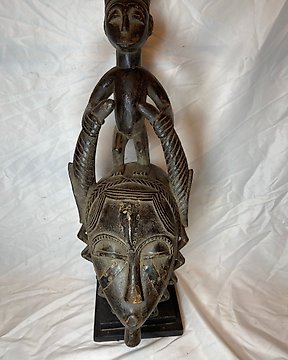
Masque - masque de danse baoulé - Côte d'Ivoire (Sans Prix de Réserve)
Nº 84084807

Nº 84084807

A rectangular Grebo mask, village Sassandra, region Ouest, Ivory Coast, with four tubelike eyes on an elongated panel, the mouth also rectangular and baring teeth, beneath a long wide in depth nose splitting the face in two parts, connected from the mouth to the protruding forehead which is decorated with triangles and circle, the top of the head is punctures with many nail forming a hair like texture, the sides of the mask are surrounded with some leather where fur remains, the mouth is also surrounded with the same type of leather, the mask has traces of washing blue pigment on the eyes cheek and forehead, attachment holes at the rim; thick encrusted patina, cracks, signs of use, the inside of the mask is lined with a padded textile. incl. stand.
The masks that are created represent the spirits of the hidden world that dwell within the forests. Skilled initiates are responsible for their production, and they are used during special ceremonies for initiates and public festivals. This particular mask belongs to the category of plank masks with tubular eyes, which tend to have a more abstract appearance.
The interest of cubist painters and modern sculptors in the abstract of the Grebo mask can be seen in some of their works, such as Picasso´s 1914 guitar.
Lit.: Christopher D. Roy/Thomas G.B. Wheelock: Land of the Flying Masks. Art and Culture in Burkina Faso
“The Grebo use several types of masks, some used for adult initiation or religious ceremonies. The most commonly seen is the war mask, used by warrior societies and formed in the shape of a plank with cylindrical eyes, numbering between two and twelve. The mask is danced in preparation for war and at the funerals of warriors.”
Lit: Second Face, Museum of Cultural masks
Bassani, La Grand Heritage, Florence, 1992:262 is writing about this mask, states this is a classical example of the geometric style of Greba masks. On the lower flat side, the features are rendered by rigorous volumes - two cylinders for the eyes, a pyramid for the the nose and a parallelogramm for the lips. The mask is a precise geometric form which accentuated the architectural plastic qualities. Indeed Picasso was inspiered by the related mask which he purchased in Marseille in 1912 when he created the "Guitar", now in the Museum for Modern Art, New York (Rubin, Primitivism in the Art of the 20th century, 1984:20 - 21).
The Picasso Grebo Mask of 1912 and the sculpture "Guitar", created in the same year (last photo sequence).
"The Grebo people inhabit the coast of Eastern Liberia and surrounding forests, and are a small ethnic group named after their migration from the Sahara region to Liberia, translating to "leaping monkey people." Known for their ferocity in battle, the construction of their mask work reflects their warrior culture, with flat war masks featuring 3D tubular eyes measuring up to a meter in height. These masks make appearances not only during battles but also at pre-dance rituals and funerals of fallen warriors.
Aside from war masks, the Grebo also create tall, flat masks with large faces and painted "buffalo horns," as well as masks that represent the ideal female, characterized by slitted eyes and a gentle expression. Both of these mask types are used during initiation rites and festive events.
Grebo masks have notably influenced the works of Pablo Picasso, who, alongside Georges Braque, created Cubism, a style that portrays subjects in 2D while combining multiple perspectives into one image. Picasso purchased a Grebo mask in the early 1900s, which inspired him as he developed Cubism, culminating in one of his most well-known works, Les Demoiselles d'Avignon, featuring five nude women with angular bodies and faces inspired by the Grebo mask."
Lit: The Metropolitan Museum of Art.
Comment acheter sur Catawiki ?
1. Découvrez des objets d’exception
2. Faites la meilleure offre
3. Effectuez un paiement sécurisé